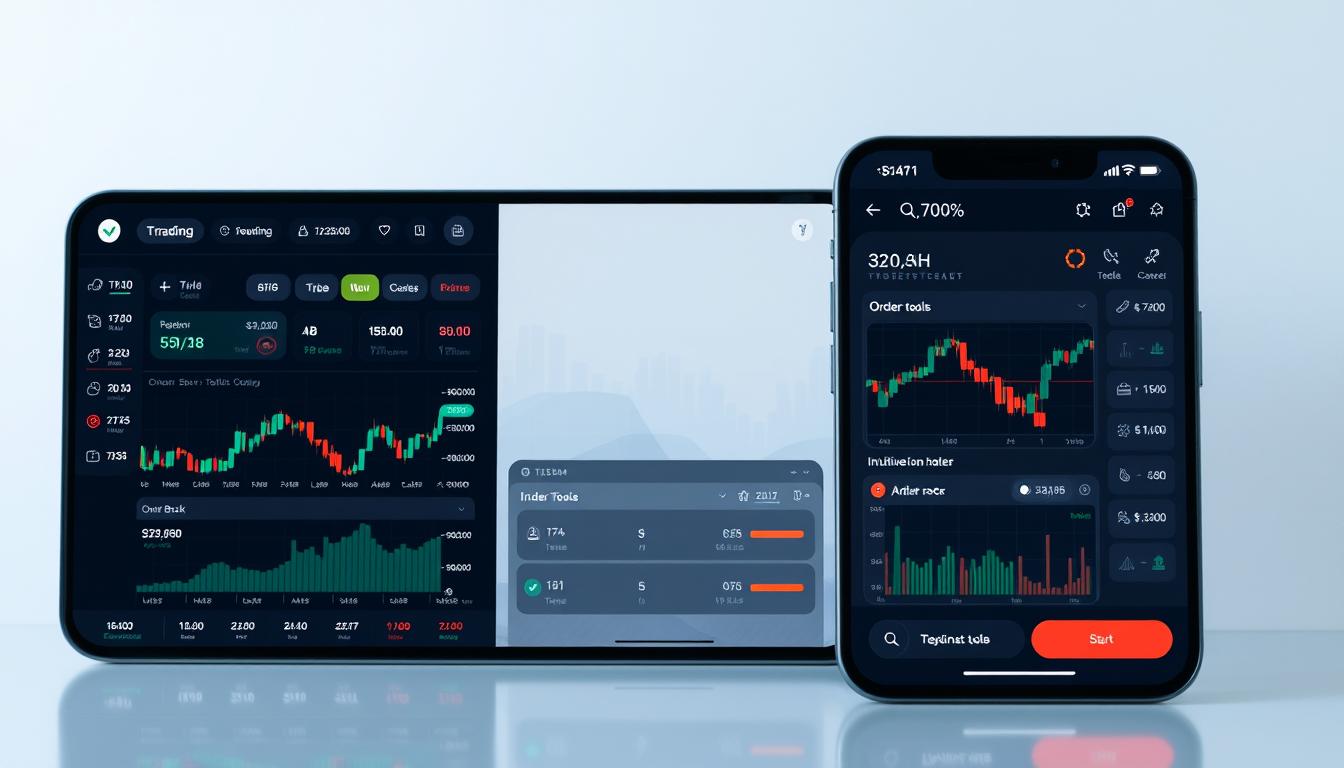Now Reading: Navigating Crypto Trading Platforms: A Step-by-Step Guide
- 01
Navigating Crypto Trading Platforms: A Step-by-Step Guide
Navigating Crypto Trading Platforms: A Step-by-Step Guide
Entering the world of cryptocurrency exchange can feel overwhelming, especially for newcomers. With so many crypto trading platforms out there, knowing how to use them is key to success.

A crypto trading platform connects buyers and sellers, making transactions easier. It also offers tools for analyzing the market. To get the most out of these platforms, it’s important to understand their features and how they work.
This guide will teach you the basics of using these platforms. It aims to make your trading experience smooth and informed.
Key Takeaways
- Understanding the role of a cryptocurrency exchange
- Identifying key features of a crypto trading platform
- Navigating the platform’s interface and tools
- Managing transactions and security
- Utilizing market analysis resources
Understanding the Cryptocurrency Trading Landscape
Getting to know the cryptocurrency trading world is key for anyone wanting to do well in digital assets. This market is different from traditional ones. It has its own special traits.
The Evolution of Digital Asset Trading
Since Bitcoin started in 2009, digital asset trading has changed a lot. It was small at first but now it’s big, with many people involved. New tools and technologies have made it easier to trade cryptocurrencies.
Online trading platforms have helped this growth a lot. They let users easily buy, sell, and trade cryptocurrencies. These platforms also offer new products and services, like derivatives and margin trading.
Key Differences Between Traditional and Crypto Markets
Traditional and cryptocurrency markets are different in how they work. Traditional markets have central authorities controlling transactions. But, cryptocurrency markets are decentralized, allowing direct transactions between people.
Cryptocurrency markets are also very volatile. Prices can change a lot in a short time. This can be both good and bad for traders. Also, these markets are open 24/7, unlike traditional ones.
Knowing these differences helps traders adjust their strategies for the cryptocurrency market. By understanding digital asset trading, traders can make better choices on online platforms.
What Makes a Good Crypto Trading Platform
To trade cryptocurrencies, you need a platform with key features, strong security, and clear fees. A secure trading platform is key for safe trading. It keeps your transactions safe.
Essential Features to Look For
A good platform should be easy to use, have strong trading tools, and reliable support. Advanced charting tools and up-to-date market data help you make smart trades. It should also offer various order types for different strategies.
Security Considerations
Security is crucial in crypto trading. A secure trading platform uses 2FA, encryption, and cold storage. It also does regular security checks and follows rules to keep your money safe.
Fee Structures Explained
Knowing a platform’s fees is important to avoid surprises. Fees can include maker and taker fees, withdrawal, and deposit fees. Some offer discounts for big traders or users of their tokens. Always check these fees to find a trading software that’s good for your wallet.
By looking at these points, traders can pick a platform that fits their needs and improves their trading.
Types of Crypto Trading Platforms Available Today
It’s important to know about the different crypto trading platforms. The market has many, each with its own benefits and drawbacks.

Centralized Exchanges (CEX)
Centralized exchanges are the most popular crypto investment platforms. They are run by a central authority, making them easy to use and highly liquid. Sites like Coinbase and Binance are examples. They offer fast transactions and good customer support.
But, they can be hacked and require trust in the central authority.
Decentralized Exchanges (DEX)
Decentralized exchanges use blockchain technology. They allow direct transactions between users, without a central authority. This makes them secure and gives users control over their assets.
DEXs are transparent and can’t be censored. But, they have less liquidity and can be hard for beginners to use.
Hybrid Platforms
Hybrid platforms try to mix the good parts of both CEX and DEX. They offer the security of DEXs and the ease of CEXs. They are still new but could be a great option for the future.
They aim to provide a better trading experience by combining the best of both worlds.
In summary, the right platform depends on what you value most: security, ease, or control. Knowing the differences between CEX, DEX, and hybrid platforms helps investors make better choices.
Setting Up Your First Crypto Trading Account
Setting up your first crypto trading account is a big step. It needs careful thought about several things. Understanding how to create an account on a crypto trading platform is key.
Choosing the Right Platform for Beginners
For newbies, picking a platform that’s easy to use and safe is important. A secure trading platform should be simple to use. Look for platforms with low fees, lots of cryptocurrencies, and good customer support.
Account Verification Process
After picking a platform, you need to verify your account. This step is important for following rules and keeping your account safe.
KYC Requirements
Most good crypto trading platforms need you to follow Know Your Customer (KYC) rules. This means you have to show personal ID documents to prove who you are. The exact documents needed can vary, but usually, it’s a government ID and proof of where you live.
Document Submission Tips
To make the verification process go smoothly, make sure your documents are clear and easy to read. Also, check that your documents are current and valid. Some platforms might have special rules for what documents they accept, so it’s good to check their guidelines.
Securing Your Account
Once your account is verified, focus on making it secure. Turn on two-factor authentication (2FA) for extra protection. Also, use a strong, unique password and keep your login details private.
By following these steps and choosing a secure trading platform, you can set up your first crypto trading account with confidence. Then, you can start your trading journey.
Funding Your Crypto Trading Platform Account
Choosing a reliable online trading platform is the first step. Then, you need to fund your account to start trading cryptocurrencies. Each platform has its own way to fund your account, but most offer easy options.
Payment Methods Available
Most platforms let you pay with bank transfers, credit/debit cards, and e-wallets like PayPal. Some even let you deposit cryptocurrencies directly from your wallet. Make sure to check what payment methods your platform supports.
Choosing a payment method you’re used to makes things easier. For example, if you’re comfortable with credit cards online, pick a platform that accepts them.
Understanding Deposit Timeframes
Deposit times vary based on your payment method. Bank transfers can take days, while card transactions are usually instant. Cryptocurrency deposits are often quick, taking just minutes.
Knowing these times helps you plan your trades better. If you want to trade fast, choose a payment method that processes quickly.
Managing Transaction Fees
Transaction fees are another thing to consider. Different methods have different fees. For example, card transactions might cost more than bank transfers. It’s important to know these fees to avoid surprises.
Some platforms offer discounts or promotions for certain payment methods. Look out for these to save on trading costs.
By understanding your platform’s payment methods, deposit times, and fees, you can fund your account efficiently. This lets you start your crypto trading journey smoothly.
Navigating the User Interface of Popular Crypto Trading Platforms
Trading digital assets well needs market knowledge and a good grasp of the trading platform’s interface. Platforms like Coinbase, Binance, and Kraken are well-known among traders. Knowing how to use these platforms is key for both new and seasoned traders to trade well and manage their portfolios.

Coinbase Interface Walkthrough
Coinbase is great for beginners because of its easy-to-use interface. When you log in, you see your portfolio, recent trades, and market trends. The menu is simple, making it easy to find ‘Buy/Sell’, ‘Prices’, and ‘Accounts’. Coinbase also makes placing orders easy with clear steps and little clutter.
Key Features: Easy navigation, clear transaction history, and a simple order placement process.
Binance Dashboard Explained
Binance has a more advanced interface than Coinbase, appealing to both new and experienced traders. You can customize your dashboard to fit your needs. It has real-time market data, various order types, and advanced charts. The ‘Trade’ tab is laid out simply for quick trades.
Advanced Features: Customizable dashboard, advanced charting tools, and multiple order types.
Kraken Trading Terminal Guide
Kraken’s terminal is for more advanced traders who need special tools. It has advanced order types, detailed charts, and a depth chart. You can customize it to fit your strategy. Kraken also has a ‘Classic’ mode for simpler trading.
Notable Features: Advanced order types, detailed charts, and a customizable trading environment.
In summary, knowing how to use the interfaces of popular platforms like Coinbase, Binance, and Kraken is crucial for trading success. Each platform has unique features for different trading levels. By learning these interfaces, traders can improve their trading and make better decisions.
Understanding Order Types in Crypto Trading
Getting into crypto trading means knowing the different order types on crypto trading platforms. Each order type helps traders carry out their plans, manage risks, and make more money. We’ll look at the various orders you can place on an online trading platform.
Market Orders vs. Limit Orders
A market order tells you to buy or sell a cryptocurrency at the best price available. It happens right away, which is great for quick trades. A limit order, however, lets you set a price you want to buy or sell at. It only goes through when the market price hits your target.
Stop-Loss and Take-Profit Orders
Stop-loss orders help prevent big losses by selling when the price drops to a set point. On the flip side, take-profit orders let you sell and lock in gains when the price hits a certain level. Both are key for managing risks on a crypto trading platform.
Advanced Order Types
Many crypto trading platforms also offer more complex order types. These include:
- OCO (One-Cancels-the-Other) Orders: These let you place two orders at once, with one canceling the other if it’s executed.
- Trailing Stop Orders: These adjust the stop-loss price as the market moves. They help traders lock in gains while still allowing the trade to grow.
OCO (One-Cancels-the-Other) Orders
OCO orders are great for setting both a take-profit and a stop-loss at the same time. This can improve your strategy.
Trailing Stop Orders
Trailing stop orders are good for making more money in rising markets while protecting against losses.
Knowing and using these order types can really boost your trading strategy on any crypto platform. By mastering market orders, limit orders, stop-loss, take-profit, and advanced types, traders can handle the crypto market better.
Reading and Interpreting Crypto Charts
Understanding crypto charts is key for traders. These charts show market data visually. They help traders spot patterns and trends, which is vital for making smart trades.
Candlestick Patterns Explained
Candlestick patterns are a big part of chart analysis. They hint at market moves and help predict prices. Traders use them to plan their trades.
Bullish Patterns
Bullish patterns hint at price going up. Patterns like the hammer and engulfing are common. They tell traders it’s a good time to buy.
Bearish Patterns
Bearish patterns suggest prices might fall. Patterns like the shooting star and hanging man are examples. Spotting these can help traders know when to sell.
Key Technical Indicators for Beginners
Technical indicators use math to analyze price and volume. For newbies, knowing Moving Averages (MA), Relative Strength Index (RSI), and Bollinger Bands is crucial. These tools help spot trends and when to enter or exit trades.
- Moving Averages (MA): Smooths out price data to show trends.
- Relative Strength Index (RSI): Shows if prices are too high or too low.
- Bollinger Bands: Uses a moving average and standard deviations to measure volatility.
Setting Up Your Chart Workspace
A neat workspace is essential for chart analysis. Most trading software lets you customize your charts. Start with a simple setup and add more as you get better.
Executing Your First Crypto Trade: Step-by-Step
Starting your first crypto trade can feel exciting and scary at the same time. But, with the right help, you can do it with ease. A crypto trading platform gives you the tools to buy, sell, and manage your digital assets well.
Researching Your First Investment
Before you start, it’s important to do your homework. Look at market trends and the asset’s past performance. Also, keep up with news that might change its value. Use your crypto trading platform to find the information you need.
Placing a Buy Order
After picking your digital asset, it’s time to place a buy order. Go to the trading section of your platform, pick the asset, and decide how much to buy. You can choose a market order or a limit order based on your plan. Make sure you check your order details and then place the buy order.
Monitoring Your Position
After buying, keep a close eye on your investment. Watch how the market changes and adjust your plan if needed. Many crypto trading platforms offer tools to track your investments in real-time.
Executing a Sell Order
Knowing when to sell is just as important as knowing when to buy. Set goals for profit or risk limits. When you’re ready to sell, follow the same steps as buying. Pick the asset and amount to sell, confirm your order, and then sell through your digital asset trading platform.
By following these steps and using your crypto trading platform wisely, you can trade with confidence. Remember, the secret to trading well is to keep learning and adjust to the market.
Managing Risk on Crypto Trading Platforms
To do well in crypto trading, you need a solid risk management plan. The crypto market is very unpredictable. This means you could lose money as well as make it. A good risk plan helps keep your money safe and can increase your earnings.
Knowing the platform you trade on is key. A crypto investment platform with good risk tools can make trading better. These tools give you real-time market data, alerts, and different order types. They help reduce the chance of losing money.
Setting Appropriate Position Sizes
Choosing the right amount of money for each trade is important. It’s about how much of your total money you put into a trade. A good rule is to risk only a small part of your money on one trade. This way, you don’t lose too much if things go wrong.
Many traders stick to the 2% rule. This means they never risk more than 2% of their money on one trade. This rule helps keep big losses from happening.
Implementing Stop-Loss Strategies
Stop-loss orders are a must for managing risk. They close a trade when the price hits a certain point, stopping losses. To use stop-loss orders well, you need to know the market and set realistic levels.
There are different stop-loss orders, like fixed, trailing, and guaranteed. Each has its own benefits and works best in certain situations.
Portfolio Diversification Techniques
Spreading your investments is another smart risk move. By investing in different cryptocurrencies and types of assets, you lower your risk. This makes your returns more stable and reduces overall risk.
Traders can diversify by mixing big cryptocurrencies like Bitcoin and Ethereum with newer ones. Adding other assets, like commodities or stocks, can also help.
In short, managing risk in crypto trading means setting the right trade sizes, using stop-loss orders, and diversifying. These steps help protect your money and increase your chances of success in the crypto markets.
Advanced Features of Crypto Trading Platforms
Crypto trading platforms are getting better with new features. These updates help all traders, from newbies to experts. Let’s look at the cool tools and services these platforms now offer.
Margin Trading Capabilities
Margin trading lets traders use borrowed money to grow their trades. This can lead to bigger wins, but also bigger losses. Many platforms now offer margin trading, giving traders more ways to play the market.
Futures and Options Trading
Futures and options are for those who like to bet on crypto prices. Futures contracts mean you have to buy or sell something at a set price later. Options let you choose to buy or sell at a set price, but you don’t have to. These are for the more experienced traders who want to take risks.
Staking and Earning Interest
Some platforms let you stake your crypto to help the blockchain network. This can earn you rewards or interest. It’s a way to make money while supporting the network.
API Access for Automated Trading
For the tech-savvy, many platforms offer API access for automated trading. This lets you create bots or algorithms to make trades for you. API access helps advanced traders make more precise trades.
These new features show how crypto trading platforms are growing. They offer a wide range of tools for all kinds of traders in the digital world.
Mobile Crypto Trading: Apps and Strategies
Mobile crypto trading apps have changed how we invest in digital assets. They offer great convenience and flexibility. Now, investors can trade anytime, responding quickly to market changes.
Top Crypto Trading Apps Compared
Many crypto trading apps are popular among investors. Coinbase and Binance are favorites for their easy-to-use interfaces and wide selection of cryptocurrencies. When choosing, consider fees, security, and the types of trades you can make.
Security Considerations for Mobile Trading
Security is key in mobile crypto trading. Look for apps with two-factor authentication and encryption. Also, keep your app and device up to date to stay secure.

Setting Up Alerts and Notifications
Most apps let you set up alerts and notifications. With price alerts, you can keep up with market changes easily. This is great for managing risk and making quick investment choices.
Common Pitfalls When Using a Crypto Trading Platform
Using a crypto trading platform can be tricky. It’s important to know the common mistakes that can affect your success. By understanding these pitfalls, you can make better choices.
Avoiding Scams and Phishing Attempts
Scams and phishing are big risks in crypto trading. Scammers create fake sites or emails to trick you into giving away personal info. To stay safe, always check if a website is real and avoid emails that ask for your login or money.
- Always check the URL for HTTPS and ensure it’s the official website of the crypto trading platform.
- Be wary of emails or messages asking for login credentials or financial information.
- Enable two-factor authentication (2FA) to add an extra layer of security to your account.
Managing Emotional Trading Decisions
Emotions can also lead to big losses in trading. Fear and greed can cause you to make quick, bad decisions. Having a trading plan and sticking to it can help control your emotions.
- Set clear goals for your trading activities.
- Use stop-loss orders to limit potential losses.
- Regularly review your trading strategy to ensure it remains aligned with your goals.
Understanding Tax Implications
Trading crypto comes with tax rules you need to know. Taxes on crypto vary by place, and how crypto is taxed can change a lot. It’s smart to talk to a tax expert to follow the law.
- Keep detailed records of all your trades to facilitate tax reporting.
- Understand the tax implications of different types of trades, such as margin trading or staking.
- Consult with a tax advisor to ensure compliance with local tax laws.
The Future of Digital Asset Trading: Where Crypto Trading Platforms Are Heading
The world of digital asset trading is changing fast. New tech and rules are leading the way. Online trading platforms will keep playing a big role in this change.
Artificial intelligence and machine learning will soon be big in digital asset trading. They will make trading smarter and safer. Also, decentralized finance (DeFi) will grow, giving users more control over their money.
Expect better security, easier-to-use platforms, and more learning resources for traders. To stay on top, traders need to keep up with these changes. This way, they can confidently move through the changing world of digital asset trading.
FAQ
What is a crypto trading platform?
A crypto trading platform is an online place where you can buy, sell, and trade cryptocurrencies. It’s a safe space for transactions. It also has tools to help you make smart choices.
How do I choose the right crypto trading platform?
Look at security, fees, the types of cryptocurrencies, how easy it is to use, and customer support. Compare different platforms to find the best one for you.
What is the difference between a centralized exchange (CEX) and a decentralized exchange (DEX)?
A CEX is run by one company, like a traditional exchange. A DEX works on blockchain and is run by many, allowing direct trades without middlemen.
How do I secure my crypto trading account?
Use two-factor authentication (2FA), strong passwords, and keep your login info secret. Also, think about using a hardware wallet to keep your crypto offline.
What are the most common payment methods accepted by crypto trading platforms?
You can use bank transfers, credit/debit cards, and PayPal. Some platforms also accept e-wallets.
How do I read and interpret crypto charts?
Learn about technical indicators like candlestick patterns and moving averages. Understanding these helps you make better trading choices.
What is margin trading, and how does it work?
Margin trading lets you borrow money to trade with more money, which can increase your gains and losses. Know the risks before using it.
How do I avoid scams and phishing attempts on crypto trading platforms?
Be careful with links and login info. Check emails and messages for realness. Never share sensitive info with unknown sources.
What are the tax implications of crypto trading?
Taxes on crypto trading depend on where you live and your situation. Talk to a tax expert to understand your taxes and follow the law.
Can I use a crypto trading app on my mobile device?
Yes, many platforms have mobile apps for iOS and Android. Use strong passwords and keep your device updated for mobile security.











